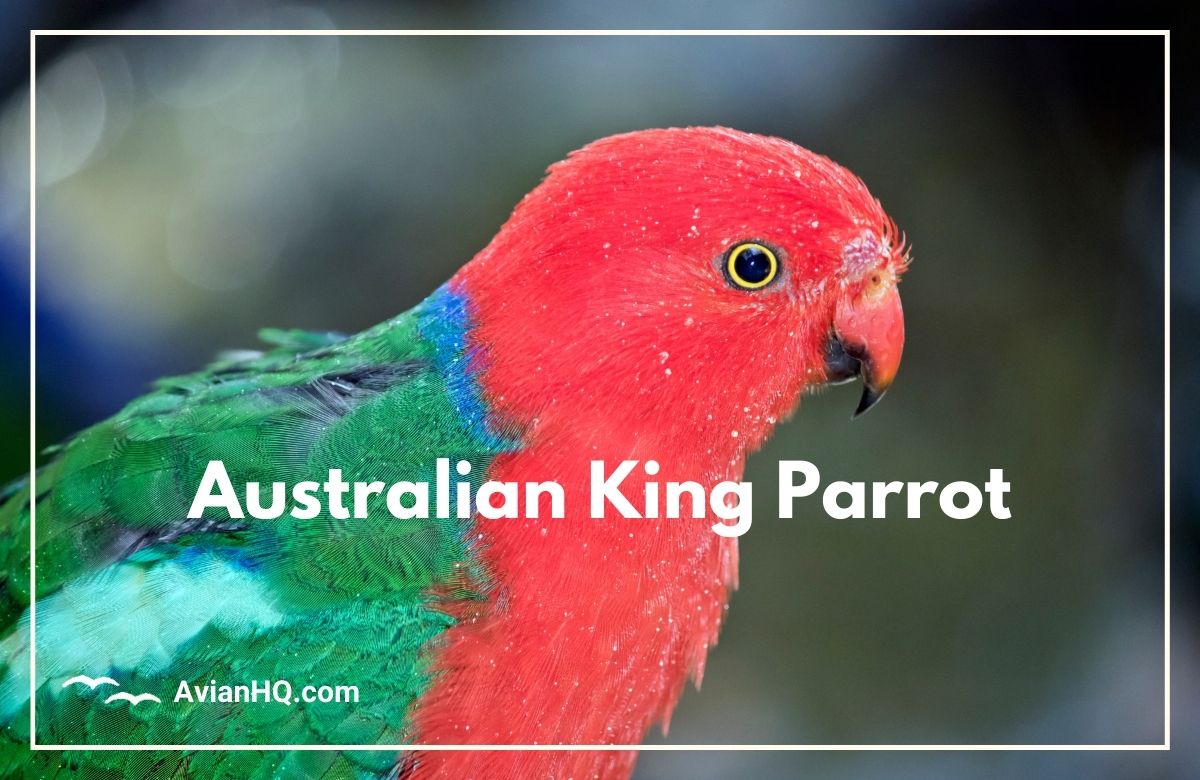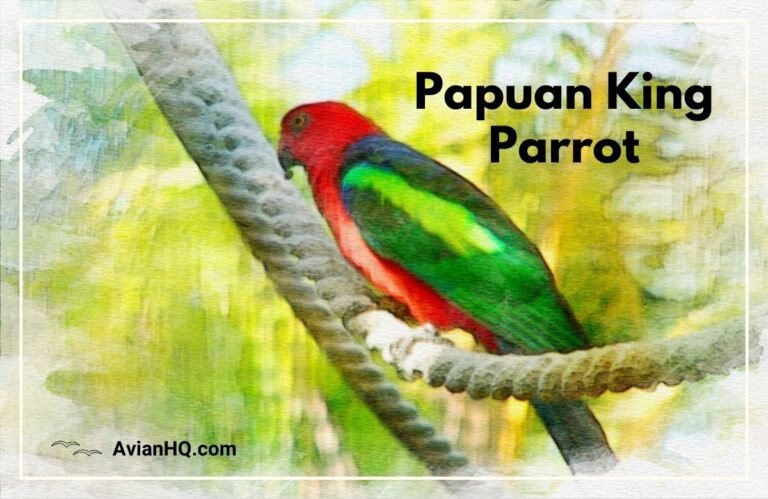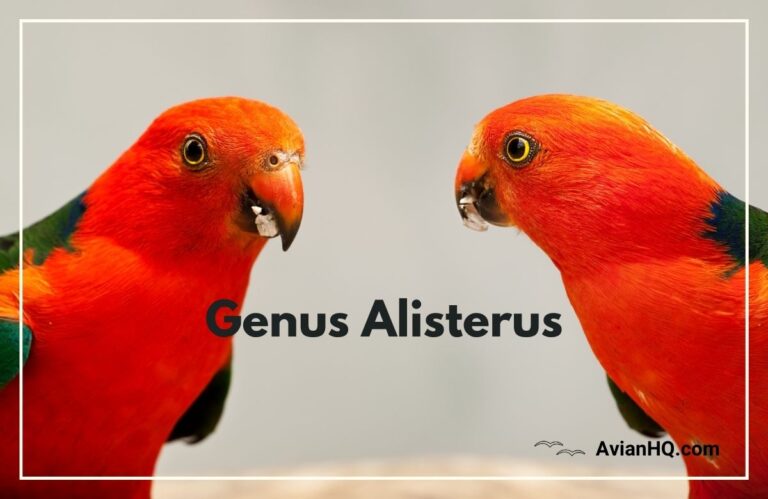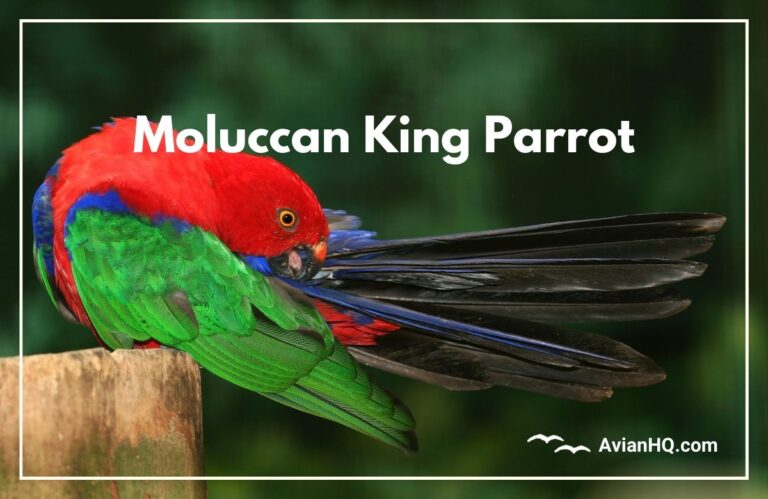Australian King Parrot (Alisterus scapularis)
With it’s brilliant plumage in striking shades of red, green, and blue, the Australian King Parrot is one of the most colorful and eye-catching bird species found across eastern Australia. This iconic parrot is endemic to the coastal forests on Australia’s eastern side, ranging from the tropical rainforests of northern Queensland down to the temperate woodlands of Victoria.
Though widespread, the Australian King Parrot inhabits specific forest habitats like wet sclerophyll forests and areas where eucalyptus woodlands transition into subtropical rainforest. It is most abundant in regions with plenty of fruiting trees and a mix of dense forest plus more open woodlands.
With a total body length of around 16-17 inches (40-43 cm) and weight between 6.8-9.6 ounces (195-275 grams), the King Parrot is one of the larger parrots found in Australia. It has a long tail and a heavy bill suited for cracking hard nuts and seeds. The male and female have dramatically different coloration, a form of sexual dimorphism common among parrot species.
The taxonomy and classification of the Australian King Parrot has been recently updated based on genetic analysis and today most authorities recognize two subspecies:
- Alisterus scapularis scapularis – The nominate and more widespread subspecies found along Australia’s southeastern coast through Victoria
- Alisterus scapularis minor – A smaller subspecies restricted to northeastern Queensland
In the wild, the King Parrot feeds on a diverse diet of seeds, fruits, nectar, and some insects, moving between the forest canopy and ground. It is an agile flyer capable of weaving through dense forests. King Parrots breed in the southern hemisphere spring and summer, nesting in large tree hollows.
Though not globally threatened, the King Parrot’s numbers are declining across parts of it’s range due to ongoing habitat destruction. However, it has adapted well to wooded suburbs and parks and can be seen on bird feeders in urban areas. The King Parrot is also bred in aviculture within Australia and prized for it’s bright colors despite a reputation for being nippy.
This article will provide an in-depth profile of the Australian King Parrot, covering it’s appearance, habitat, ecology, behavior, conservation status, and cultural significance. We’ll highlight some of the most interesting facts about this flashy forest-dweller and explain why it remains a favorite among Australia’s many colorful parrots.
Scientific Classification and Discovery
The Australian King Parrot was first described scientifically in 1816 by the German naturalist Martin Lichtenstein, based on specimens collected in New South Wales. He originally named it Psittacus scapularis, classifying it within the large parrot genus Psittacus.
Over the next two centuries, the King Parrot was reclassified into multiple different genera including Aprosmictus, Platycercus, and Barnardius before eventually being placed in it’s current genus Alisterus.
The genus name Alisterus is derived from the Greek word alistos meaning “unforgettable”, likely referring to the parrot’s bright red plumage. The specific epithet scapularis refers to the distinct shoulder patches or “epaulettes” on the wings.
Today, most taxonomic authorities recognize two subspecies of the King Parrot:
- Alisterus scapularis scapularis – The nominate subspecies described by Lichtenstein found along the southeastern Australia coast from central Queensland to Victoria.
- Alisterus scapularis minor – A smaller subspecies native to northeastern Queensland first described in 1911 by Gregory Mathews. It is around 5 inches (12 cm) shorter in length than the nominate race.
These two subspecies have slightly different geographic distributions along Australia’s eastern coast. There is also natural hybridization in a contact zone between A. s. scapularis and the Red-winged Parrot (Aprosmictus erythropterus) occurring in southeastern Queensland.
Overall, the Australian King Parrot belongs to the diverse parrot family Psittaculidae. Recent genetic analysis has shown that it’s closest relatives are the other two Alisterus king parrots from New Guinea and the Moluccas. Morphologically and behaviorally it also shares similarities with other Australasian parrots in the tribe Platycercini.
Physical Description
The Australian King Parrot is a relatively large, stocky parrot that measures around 16-17 inches (40-43 cm) in total length including it’s long tail. It weighs between 6.8-9.6 ounces (195-275 grams) on average. The wingspan is approximately 11 inches (28 cm).
The most striking feature of this species is the dramatic difference in plumage coloration between males and females, a form of strong sexual dimorphism.
Male Plumage
- Head, neck, chest, belly – Brilliant crimson red
- Back and wings – Dark green with bluish tint on upper back
- Lower rump – Vibrant turquoise-blue
- Shoulder patches – Pale silvery-green bands on bend of wings
- Tail – Long and green with black underside
- Bill – Reddish-orange upper mandible with black tip, black lower mandible with orange base
- Eyes – Yellow irises
Female Plumage
- Head, neck, chest, back – Mostly green
- Lower chest, belly – Reddish-orange
- Shoulder patches – Absent or very small
- Tail – Dark green with pink tip
- Bill – Horn-colored gray bill
- Eyes – Dark brown irises
The differences in plumage and size between the two subspecies are relatively minor. A. s. minor is smaller, measuring only around 12 cm shorter than the nominate subspecies. In both subspecies, juveniles resemble adult females but have duller plumage overall until their first molt.
The brilliant red plumage on the male King Parrot comes from special red psittacofulvin pigments in the feathers. Interestingly, some of the wing feathers glow a bright yellow under ultraviolet light thanks to a fluorescing compound. Many birds can see into the UV spectrum with special retinal cones.
The long tails and heavy bills of King Parrots are morphological adaptations suited to their arboreal lifestyle in Australia’s forests. Their powerful bills allow them to crack hard nuts and seeds.
Geographic Range and Habitat
The Australian King Parrot is endemic to the eastern coastal region of Australia, ranging from the wet tropical rainforests of far northern Queensland southward to the cool temperate forests of Victoria.
Native Range
- Occurs along the entire eastern coastline from Cooktown in Queensland to Port Campbell in Victoria
- The nominate subspecies (A. s. scapularis) occupies the bulk of the range in southeastern Australia
- The minor subspecies (A. s. minor) is restricted to northeastern Queensland
Elevation
- Inhabits forests at a wide range of elevations
- Found at elevations up to 5,300 feet (1,600 m) in some areas
- More common at lower elevations below 3,300 feet (1,000 m)
Habitat
Favors forests with a dense understory and plenty of fruiting trees:
- Rainforests – Tropical, subtropical, and temperate rainforests
- Wet sclerophyll forests – Open eucalyptus forests with a wet understory
- Woodlands – Especially along borders with rainforest
- Parks and farms – Visits orchards and wooded areas
Requires tree hollows of large old trees for nesting. Most abundant where it’s forest habitat remains intact. However, it has adapted well to living in wooded suburbs and parks provided adequate tree cover.
Outside the breeding season, King Parrots may wander widely into open forests, woodlands, and farms. But they rely on intact rainforest ecosystems for successful breeding.
Overall, the Australian King Parrot has a relatively widespread distribution along Australia’s eastern coast. However, localized habitat loss poses threats in some portions of it’s range.
Diet and Feeding
The Australian King Parrot is predominantly herbivorous, feeding on a diverse array of plant foods including seeds, fruits, nectar, flowers, and buds. However, it does occasionally eat insects and insect larvae as well.
Primary Foods
- Seeds – Especially from eucalyptus, acacia, angophora trees
- Fruits – Figs, berries, apples, pears, citrus
- Nectar – From native flowering plants like banksia
- Flowers and buds
- Insects – Larvae, moths, beetles
Favorite wild foods include mistletoe berries, fruit of the silky oak tree, and seeds from acacias. At backyard feeders, king parrots readily eat sunflower seeds, milo, oats, and apples.
Foraging Strategy
- Forages primarily in trees but will come to ground for fallen fruit/seeds
- Uses strong bill to crack open hard nuts and acacia pods
- Feeds actively at dawn and late afternoon
- Wary and quiet while feeding compared to other parrots
King Parrots use their curved upper bill like a pair of forceps when extracting seeds. They hold large seeds steady with their feet when cracking them open. The long cylindrical tongue is used to extract nectar from flowers.
These birds get moisture from the foods they eat but will visit water sources like ponds and bird baths regularly. In dry habitats, they remain close to riparian areas.
Overall, the King Parrot is well adapted to extracting seeds and nectar from Australia’s native forests. It consumes a wide variety of both native and cultivated fruits and plants.
Breeding and Reproduction
The Australian King Parrot breeds during the southern hemisphere spring and summer between August and January. It is a monogamous species that mates for life.
Courtship and Pairing
- Forms permanent pair bonds
- Courtship displays include wing flapping and beak touching
- Males feed female during courtship
Nest Sites
- Nests in hollows of large, old eucalyptus and acacia trees
- Entrance to hollow around 32-65 feet (10-20 m) high
- Nest chamber near ground around 1-3 feet (0.5-1 m) up
- Uses decayed wood as nest material
Clutch Size
- Lays between 4-6 eggs per clutch
- Eggs are rounded, 1.3 x 1.0 inches (33 x 27 mm)
- Off-white in color
Incubation and Fledging
- Only female incubates eggs
- Incubation period is 20 days
- Chicks fledge at around 5 weeks old
- Fledglings dependent on parents for several more weeks
Both parents feed and care for the chicks once they’ve hatched. Young stay with their parents for an extended period as they learn to forage on their own.
These parrots can live up to 25 years in the wild. Their breeding success is heavily reliant on the availability of large nest trees within mature forests. Loss of these key resources threatens populations in some areas.
Behavior and Ecology
The Australian King Parrot exhibits some interesting behaviors and adaptations to life in the forests of eastern Australia.
Social Behavior
- Usually found in pairs or small family groups
- Groups forage and roost together
- Larger flocks form after breeding season
- Flocks can contain up to 50 birds
- Mixed flocks with rosellas and other parrots
Roosting
- Roosts in tree hollows or dense foliage at night
- Males roost closer to entrance, protecting females further inside
- Heat-conserving huddling behavior on cold nights
Flight and Movement
- Direct, swift flight just below canopy level
- Zigzagging motions weaving through trees
- Can fly up to 31 mph over short distances
- Acrobatic mobility while climbing through branches
Vocalizations
- Variety of loud squawks, chirps, whistles
- Alarm call is harsh squealing sound
- Males make high-pitched warbling sounds when breeding
Interactions with other species
- Competes with other birds for nest hollows
- Nectar-feeding brings it into contact with lorikeets
- Sometimes chased by territorial birds for visiting feeders
Overall, King Parrots are highly social and active birds specialized for life in the forests. Their bright colors and sounds help them find mates and interact in flocks. They co-exist alongside many other Australian parrot species.
Conservation Status
The Australian King Parrot is evaluated as Least Concern on the IUCN Red List of Threatened Species. However, it’s numbers are decreasing in some portions of it’s range.
Population and Trends
- No overall population estimate available
- Classified as common and widespread
- Decreasing in areas with heavy habitat loss
- Increasing in some urban areas
Major Threats
- Habitat loss from land clearing and logging
- Competition for nest hollows
- Illegal capture for the pet trade
- Vehicle collisions in suburban areas
Protection
- Legally protected under Australian law
- Classified as protected wildlife in Queensland
- CITES Appendix II listed species
- Some habitat protected in reserves
While still relatively common, the King Parrot has disappeared from some heavily cleared or logged forests. Preserving mature stands with nesting trees is vital for breeding.
This adaptable species persists well in urban parks, gardens, and bushland provided there is adequate tree cover. It has even increased in some areas due to planting of fruiting trees. Careful monitoring of populations will be needed into the future.
Overall, the Australian King Parrot warrants continued conservation attention. Protecting it’s forest habitat across it’s range is key to ensuring the species persists long-term.
Cultural Significance
The bright colors and charismatic nature of the Australian King Parrot have made it significant culturally and as an aviary bird.
Aviculture
- Selectively bred in Australia for color variations
- Valued for beauty despite reputation for aggressiveness
- Minimum aviary size of 10 x 10 feet (3 x 3 m) recommended
- Average lifespan in captivity is 25-30 years with proper care
Suitability as Pets
- Sometimes kept as pets when hand-raised
- Generally not as affectionate or “talkative” as other parrots
- Require lots of toys and enrichment to thrive in captivity
Status as National Icon
- Features prominently in Aboriginal oral traditions
- Symbol of Queensland’s tropical north
- Common motif in artwork and jewelry
Tourism Value
- Major draw for birdwatchers in eastern Australia
- Iconic species highlighted by ecotour operators
- Fuels avitourism industry across it’s range
The King Parrot remains a flagship native bird in Australia. While aviculture and the pet trade have risks, responsible captive breeding provides educational value. Ongoing habitat conservation is vital for maintaining wild populations of this colorful parrot long-term.
Conclusion
With it’s vibrant red, green, and blue plumage, the Australian King Parrot is one of the most brightly colored and eye-catching birds across eastern Australia. This iconic parrot is endemic to the coastal forests spanning tropical Queensland down into temperate Victoria.
The King Parrot inhabits a range of wooded habitats from rainforests to open eucalypt woodlands. It feeds on the fruits, seeds, and nectar of native trees but also readily visits backyard bird feeders.
Though not threatened overall, habitat loss in portions of it’s range poses concerns for conservation. Preserving stands of mature trees needed for nesting sites is particularly vital.
Culturally, the King Parrot remains an important national symbol and is bred in aviculture for it’s beauty. Responsible captive breeding programs help ensure this species continues to dazzle people with it’s amazing colors for generations to come.
With a combination of reverence and research, Australians can both cherish the King Parrot as an iconic native bird and protect the forests it depends on. Ongoing efforts to conserve habitat across it’s range will help guarantee wild populations of this avian Aussie treasure persist.





First of all I want to say fantastic blog! I had a quick question in which I’d like to ask if you don’t mind. I was curious to know how you center yourself and clear your head before writing. I have had difficulty clearing my mind in getting my thoughts out. I truly do take pleasure in writing however it just seems like the first 10 to 15 minutes are generally lost simply just trying to figure out how to begin. Any ideas or tips? Cheers!